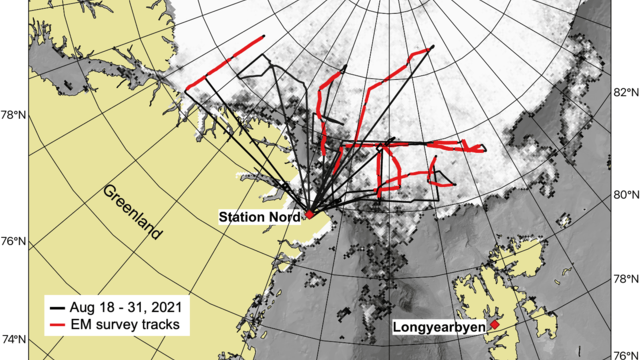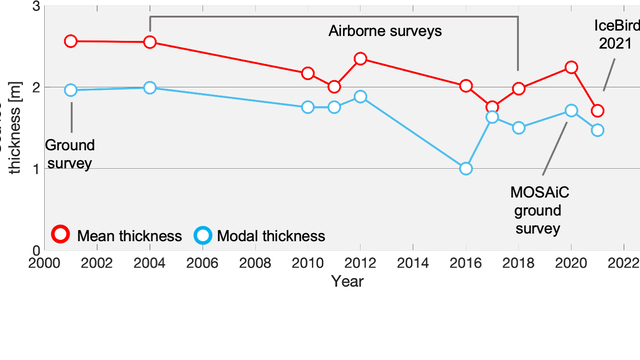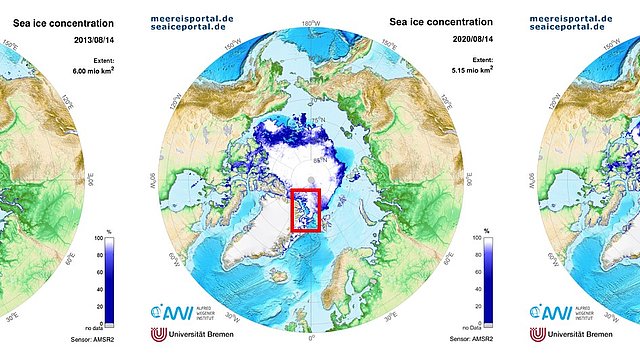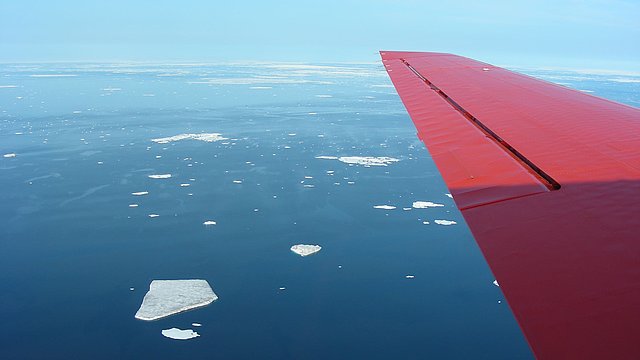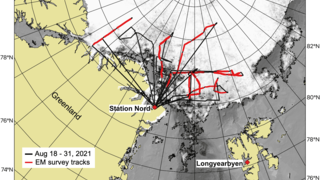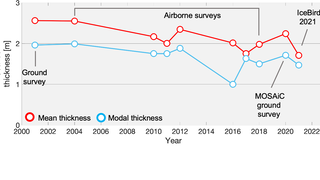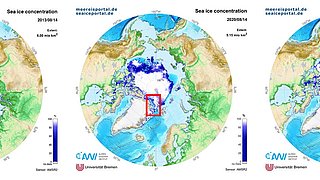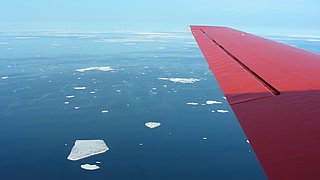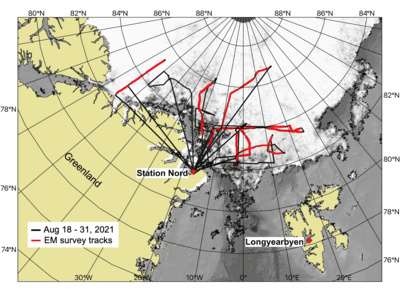After a two-year break, this year experts from the Alfred Wegener Institute, Helmholtz Centre for Polar and Marine Research (AWI) were able to return to Station Nord in northeast Greenland, to resume their annual sea-ice measurements north of Greenland and over Fram Strait. The measuring campaign MELTEX/IceBird 2021 with the aeroplane Polar 6 consisted of two parts, each with its own research focus: the goal of MELTEX (27 July – 10 August 2021) was to determine the spatial extent of meltwater ponds on the ice, and to observe the size distribution and depth of the ponds in relation to the floes’ topography. To take the measurements, chiefly the MACS camera system, developed by the German Aerospace Center (Deutsches Zentrum für Luft-und Raumfahrt (DLR)) was used, together with laser scanning to map the surface topography. The MACS system employed three different camera heads for different wavelength ranges (RGB, NIR and TIR), making it possible to record the ice cover’s optical and thermal characteristics alike.
In turn, the focus of the IceBird summer campaign (14 August – 1 September 2021) was on continuing the long-term ice thickness time series at the southern end of the Transpolar Drift. The summer campaign has been conducted by the AWI since 2010, but, due to the MOSAiC expedition and COVID-19-related restrictions, could only be pursued on a limited basis in the past two years. Whereas the measuring aircraft could only operate from Longyearbyen, Svalbard in 2020, this year the IceBird team once again profited greatly from having Station Nord as their base of operations for accessing the Arctic Ocean (Fig. 1).
From 18 to 31 August there were a total of seven measuring flights, six of which were used for extended EM Bird measurements of the ice thickness (Fig. 1). Due to the considerable spatial coverage of the aerial measurements in 2021, an extensive dataset was successfully added to the long-term ice thickness time series at the southern end of the Transpolar Drift. Whereas the mean ice thickness of 1.71 m represented a new record low in the IceBird time series, the modal ice thickness (1.47 m) was similar to the figures from the past several years (Fig. 2).
Aerial measuring campaigns like MELTEX/IceBird especially depend on the prevalent weather conditions. In this regard, it’s important to have stable conditions at the launch base (Station Nord) for take-off, but also and especially, to ensure a safe landing after the ca. six-hour-long flight. In addition, weather conditions in the measuring region had to be suitable for using the EM Bird. Since, when measuring the ice thickness, the probe is towed at a height of only 12-15 m over the surface of the ice, and the aircraft accordingly flies at ca. 80 m, flights are impossible when there are low-lying clouds or fog. In order to gauge the conditions in the planned measuring area in advance, various forecasts and satellite images provided by the German Weather Service (Deutscher Wetterdienst) were consulted.
Yet this summer, there was also another factor to consider, one that had a major influence on the measuring campaign – the so-called Wandel Sea Polynya: a large-scale opening in the ice cover of the Wandel Sea, off the coast of northeast Greenland (see Fig. 1). Because of this polynya, the amount of flight time that could actually be used for sea-ice measurements was much less than in previous years, since a nearly ice-free area measuring up to several dozen kilometres long had to be ‘skipped’ at the beginning and end of each flight. As such, unlike in previous years, the researchers couldn’t start measuring right from the ‘front door’ of Station Nord; they had to start much farther to the north, northwest and east.
The Wandel Sea Polynya caused quite a stir, especially last year, when RV Polarstern, as part of the MOSAiC expedition, took advantage of the especially low ice concentration in the region to transit from the original MOSAiC floe, which had since broken up in Fram Strait, to the North Pole (see Fig. 3, centre). The polynya in 2020 is described in detail in a paper by Schweiger et al., 2021, which analyses e.g. under which unique conditions the polynya formed last year, in a region normally considered to be part of the ‘Last Ice Area’ (i.e., the region in which the summer sea ice survives the longest). The combination of dynamic sea-ice movement away from the coast of Greenland over the spring and summer of 2020, and the increased absorption of solar energy in the now-open ocean, served to condition the Wandel Sea. Following several major storm events, in August 2020 the ice was pressed out of the Wandel Sea, while at the same time, the heat absorbed by the ocean in the spring and summer rose to the surface, which contributed to further ice melting and reduced ice thickness. In their paper, Schweiger et al. underscore that this development was generally promoted by the decline in multiyear ice, a product of climate change. As such, what set the year 2020 apart was the particularly pronounced atmospheric influence on the Wandel Sea in August 2020.
As can be seen in Fig. 3 (right), in August 2021 the polynya in the Wandel Sea was much smaller, though it still hampered the experts’ aerial work. And even if the Wandel Sea Polynya can’t be measured using the EM Bird, it was nevertheless one of the most impressive sights on this year’s IceBird summer campaign (see Fig. 4).
Article
Schweiger, A. J., M. Steele, J. Zhang, G. W. K. Moore, and K. L. Laidre: Accelerated sea ice loss in the Wandel Sea points to a change in the Arctic’s Last Ice Area. Commun Earth Environ 2, 122 (2021). doi.org/10.1038/s43247-021-00197-5
Contact
Questions?
Contact us via E-Mail or our contact form.
Graphics
